Aluminum Foils
What is Aluminum Foil?
Aluminum foil is a thin, flexible sheet of aluminum metal that is commonly used for cooking, food storage, insulation, and various industrial applications. It is made by rolling aluminum slabs into thin sheets, typically ranging from 0.016 mm to 0.2 mm in thickness.
Common Uses of Aluminum Foil:
Cooking & Baking – Used for wrapping food, lining baking trays, and covering dishes to retain moisture and heat.
Food Storage – Used to preserve food by preventing exposure to air and light.
Insulation – Used in construction and packaging to provide thermal and electrical insulation.
Medical & Industrial Applications – Used in pharmaceutical packaging, and electronics.
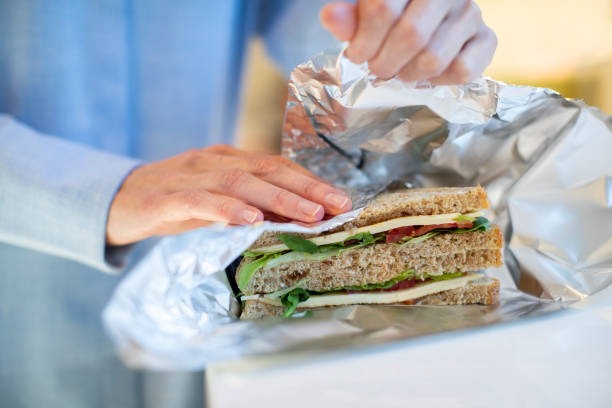

Advanced applications & Uses of Aluminum Foil
1. Cooking & Baking
Heat Retention: Keeps food warm by reflecting heat onto the food.
Crisping & Browning: When loosely tented over dishes, it prevents over-browning while allowing crisping.
Oven Shielding: Prevents overcooking or burning of certain areas by covering edges (e.g., pie crusts).
Grill Packet Cooking: Creates sealed pouches for steaming meats, fish, and vegetables on grills or in ovens.
2. Food Storage & Preservation
Extended Freshness: Wraps food tightly to prevent moisture loss and protect against freezer burn.
Odor Barrier: Blocks strong smells from spreading in the refrigerator (e.g., garlic, fish).
Cheese & Butter Wrapping: Helps prevent drying and oxidation when combined with wax paper.
3. Food Safety & Hygiene
Sterile Surface for Preparation: Acts as a clean surface for kneading dough, rolling sushi, or handling raw meat.
Prevents Cross-Contamination: Used as disposable barriers between cutting boards or utensils.
4. Specialty Cooking Applications
Sous Vide Substitute: This can be used to wrap food before submerging it in water for controlled cooking.
Solar Cooking: Used in DIY solar ovens, reflecting sunlight to concentrate heat for cooking.
Non-stick Alternative: When lightly greased, prevents food from sticking in baking and roasting.
5. Food Science & Molecular Gastronomy
Texture Control: This can modify cooking outcomes, such as keeping bread soft while crusts firm up.
Flavor Infusion: Sealed foil packets trap aromatic herbs and spices, intensifying flavors in dishes.
6. Innovative Uses in Food Service
Decorative Plating: Molded into elegant serving accents for high-end presentations.
DIY Piping Bags: Rolled into cones for decorating pastries when piping bags are unavailable.
Portable Meal Wrapping: Used for convenient packaging of takeout and campfire meals.
Property of Aluminum Foil
Aluminum foil has several key physical, chemical, and mechanical properties that make it highly useful in food applications.
1. Physical Properties
Lightweight: Extremely thin and low in density, making it easy to handle.
Flexible & Malleable: Can be easily bent, folded, or wrapped around objects.
Non-porous: Prevents the passage of air, moisture, and odors.
Reflective Surface: Reflects up to 98% of radiant heat and light.
Opaque: Blocks light, which helps prevent food degradation (e.g., prevents oxidation of fats).
2. Mechanical Properties
High Ductility: Can be rolled into thin sheets without breaking.
Tear-Resistant (in layers): While thin sheets can tear easily, multiple layers increase strength.
High Thermal Conductivity: Quickly transfers heat, making it ideal for cooking and insulation.
Temperature Resistance: Can withstand extreme temperatures, from freezing to high oven heat (~660°C melting point).
3. Chemical Properties
Non-Toxic & Food-Safe: Does not react with most foods under normal conditions.
Corrosion Resistant: Forms a natural oxide layer that prevents rusting.
Reacts with Acids & Salts: It can dissolve or degrade when exposed to acidic foods (tomatoes, citrus) or salty foods for long periods.
4. Barrier Properties
Waterproof: Prevents moisture absorption and drying out.
Gas Barrier: Blocks oxygen and carbon dioxide, preserving freshness.
Odor & Flavor Protection: Keeps strong food smells from spreading and prevents flavor contamination.
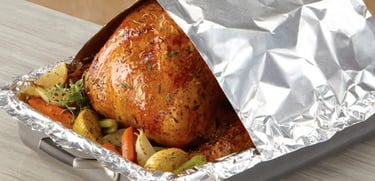

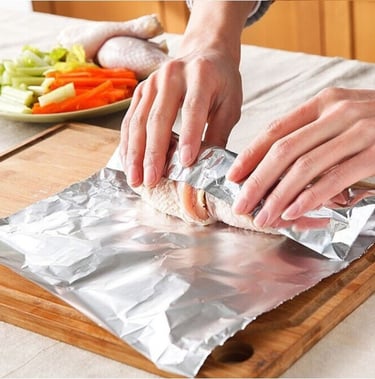

Aluminum Foil: Standard Specifications and Properties
Aluminum foil comes in various grades, thicknesses, and finishes, depending on its intended application. Here are the key specifications:
1. Thickness
Standard Household Foil: 0.016 mm – 0.024 mm (16–24 microns)
Heavy-Duty Foil: 0.025 mm – 0.05 mm (25–50 microns)
Industrial Foil: 0.05 mm – 0.2 mm (50–200 microns)
2. Alloy Composition
Common aluminum alloys used in foil production:
Soft, highly corrosion-resistant, used for packaging and household foil.
Stronger than 1100, used in cooking and industrial applications.
Most common for household and food packaging applications.
Used for pharmaceutical packaging.
3. Temper (Hardness Level)
Easily bendable, used for wrapping food.
used in industrial and heavy-duty applications.
4. Width & Length
Household Rolls: 30 cm – 45 cm (12”–18”) wide, with lengths from 10 m to 300 m.
Industrial Rolls: Can be over 1000 mm (1 meter) wide and several kilometers long.
5. Surface Finish
One Side Shiny, One Side Matte (due to rolling process).
Both Sides are Shiny (for specialty applications).
6. Applications & Special Coatings
Food-Grade Aluminum Foil – Safe for direct contact with food.
Food Safty Compliance : Aluminum Foil
Aluminum foil is widely used in food packaging and cooking, but it must meet strict food safety standards to ensure it does not pose health risks. Compliance regulations vary by region, ensuring the foil is non-toxic, contaminant-free, and safe for direct food contact.
1. International Food Safety Standards for Aluminum Foil
(A) FDA (United States) - Food & Drug Administration
Classified as "Generally Recognized as Safe" (GRAS) for food contact.
Must comply with 21 CFR 175.300, ensuring it does not leach harmful substances into food.
Acidic & Salty Foods Warning: Aluminum foil should not be used for long-term storage of acidic or salty foods, as it can cause leaching of aluminum into the food.
(B) EU Regulations - European Food Safety Authority (EFSA)
Governed by Regulation (EC) No 1935/2004, which ensures materials do not transfer harmful substances to food.
Must comply with Directive 94/62/EC, which regulates heavy metal limits in food packaging.
EFSA has evaluated aluminum migration levels and found that normal dietary exposure is safe but should be limited to high doses.
(C) BIS (India) - Bureau of Indian Standards
Standardized under IS 15392:2003, ensuring food-grade aluminum foil is hygienic, non-toxic, and free from contaminants.
Requires manufacturers to label thickness, purity, and intended use on packaging.
(D) CFIA (Canada) - Canadian Food Inspection Agency
Must meet Division 23 of the Food and Drugs Act, ensuring food contact materials are non-reactive and safe.
Similar restrictions as the FDA and EFSA on acidic food storage.
2. Safety Precautions & Compliance in Food Use
Safe Uses:
Wrapping dry foods, baked goods, meats, and vegetables.
Lining baking trays and grills.
Creating cooking pouches for steaming.
Insulating food for heat retention.
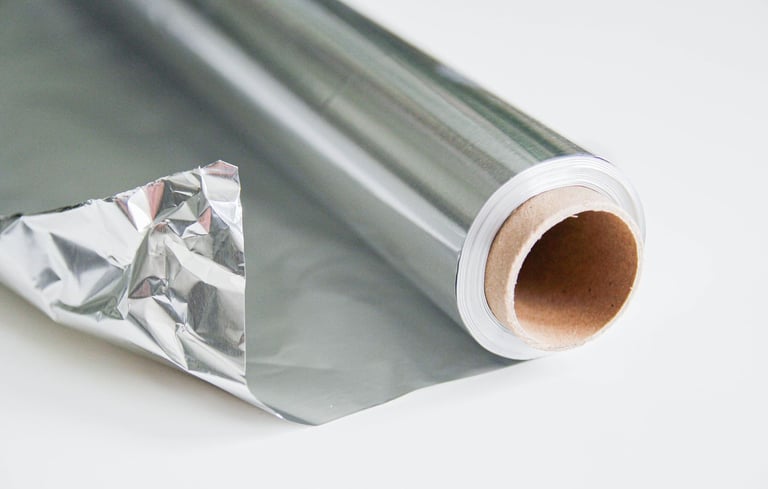

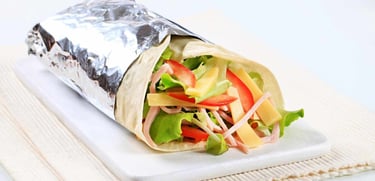

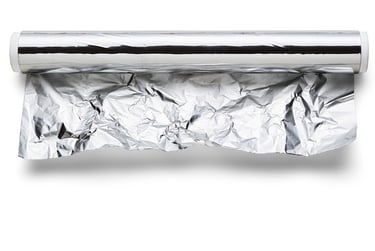

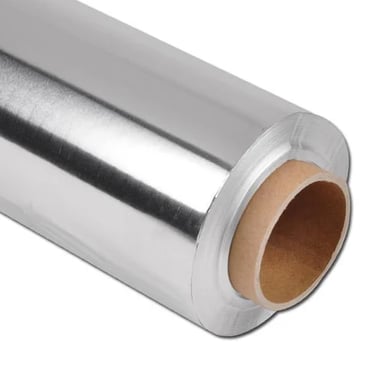

Special Features of Aluminum Foil
Aluminum foil is widely used in food, packaging, and industrial applications due to its unique properties. Below are its key features:
Physical Features
Lightweight & Thin: Easy to handle, transport, and store.
Highly Flexible & Malleable: Can be easily folded, wrapped, or molded around objects without breaking.
Reflective Surface: Reflects up to 98% of heat and light, making it excellent for insulation and heat retention.
Non-Porous & Opaque: Blocks light, moisture, and air, preserving food freshness.
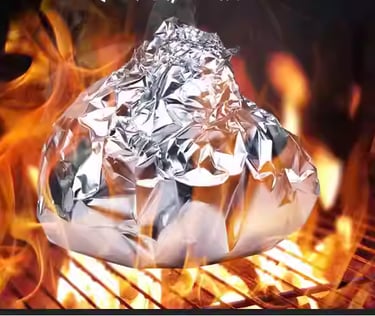

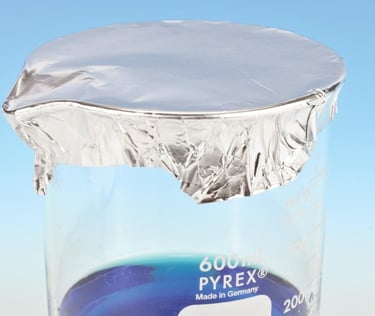

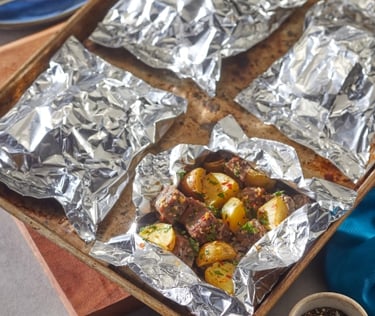

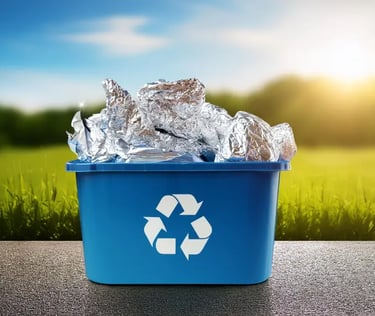

To learn more about the specifications of the product you need, please email us (info@carlton.lk) or use the WhatsApp app on this website to reach one of our sales representatives.
Thermal & Mechanical Features
High Heat Resistance:
Can withstand extreme temperatures, from freezing (-40°C) to oven temperatures (~660°C melting point).
Excellent Thermal Conductivity:
Distributes heat evenly, making it ideal for baking, grilling, and roasting.
Tear-Resistant in Layers:
While thin sheets tear easily, multiple layers increase the strength of the packaging.
Non-Toxic & Food-Safe
Approved by FDA, EFSA, BIS, and CFIA for food contact.
Corrosion Resistant:
Forms a natural oxide layer, preventing rusting.
Reacts with Acidic & Salty Foods:
Prolonged contact with tomatoes, vinegar, or citrus can cause leaching of aluminum into food.
Barrier Properties
Excellent Moisture & Odor Barrier:
Prevents food from drying out and blocks strong smells.
Gas Barrier:
Blocks oxygen and carbon dioxide, extending shelf life.
Environmental & Recyclability Features
100% Recyclable & Sustainable:
Can be recycled indefinitely without losing quality.
Energy Efficient:
Saves energy when used in cooking, packaging, and insulation.
